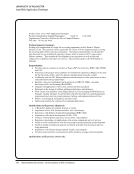SPEC Kit 340: Open Source Software · 43
Opportunity to contribute code that meets not only our specialized needs, but those of other institutions. Opportunity
for developer to join a community of developers (professional development). Reflects our commitment to the values/
mission of the university and library profession.
Opportunity to influence future directions. Opportunity to increase staff expertise through reviewing and extending OSS
code. Opportunity to leverage work at other institutions and contribute back to product.
Out of the box, relatively quick to install. Robust development community. Customizable face.
Prototyping ability to try before you buy the “free puppy.” Ability to customize to meet our needs. No licensing fees.
Provide additional services to user community. Less expensive. Greater ability to customize.
Quality of software. Ability to customize. Lower cost.
Rapid prototyping/updating. Community support. Reduced cost.
Save on licensing costs. Ability to customize, integrate with other library system. Research and publishing opportunities.
Shared expertise with other libraries. Customizability. Extensibility.
Software that is developed to meet the needs of the community rather than being profit motivated. Software that can
be customized. Strong support community.
Speed of adoption. Services provided that would not otherwise be available. Good community support.
Staff development: increasing skill and knowledge. Flexibility in terms of being able to change without penalty. Rapid
deployment: always faster to use OSS than a vendor solution for most anything.
Sustainability and influence in directing future development. More easily able to integrate other library platforms.
Financial.
The ability to customize the product. The ability to influence the direction of development.
The ability to respond quickly and effectively to the needs of our user community. The ability to troubleshoot our
systems because of the deep understanding we have of the software. OSS developer communities are more responsive
than most vendors’ support systems (at least in our experiences).
Tools and services that are designed and customized to real faculty and student workflow needs. Tools and services that
integrate into a coherent and cohesive cyberinfrastructure. Reusable code that can enable building other things.
Using WordPress instead of our parent institution’s commercial content management system allows us to develop a web
site that is more attractive, more customizable, and meets our needs.
We have the ability to do deep customization without waiting for a vendor. We keep fixed costs down by avoiding
proprietary licensing and support fees. We help improve the library OSS ecosystem by sharing our code and reusing
other code.
17. Please briefly describe up to three challenges your library encountered as a result of adopting an
OSS system and the strategies employed to overcome these challenges. N=64
Adapting the service for multiple users has been a challenge we’ve addressed it by assessing user needs and
conducting training. Systems security is a concern. We’ve addressed it through the use of penetration testing.
Opportunity to contribute code that meets not only our specialized needs, but those of other institutions. Opportunity
for developer to join a community of developers (professional development). Reflects our commitment to the values/
mission of the university and library profession.
Opportunity to influence future directions. Opportunity to increase staff expertise through reviewing and extending OSS
code. Opportunity to leverage work at other institutions and contribute back to product.
Out of the box, relatively quick to install. Robust development community. Customizable face.
Prototyping ability to try before you buy the “free puppy.” Ability to customize to meet our needs. No licensing fees.
Provide additional services to user community. Less expensive. Greater ability to customize.
Quality of software. Ability to customize. Lower cost.
Rapid prototyping/updating. Community support. Reduced cost.
Save on licensing costs. Ability to customize, integrate with other library system. Research and publishing opportunities.
Shared expertise with other libraries. Customizability. Extensibility.
Software that is developed to meet the needs of the community rather than being profit motivated. Software that can
be customized. Strong support community.
Speed of adoption. Services provided that would not otherwise be available. Good community support.
Staff development: increasing skill and knowledge. Flexibility in terms of being able to change without penalty. Rapid
deployment: always faster to use OSS than a vendor solution for most anything.
Sustainability and influence in directing future development. More easily able to integrate other library platforms.
Financial.
The ability to customize the product. The ability to influence the direction of development.
The ability to respond quickly and effectively to the needs of our user community. The ability to troubleshoot our
systems because of the deep understanding we have of the software. OSS developer communities are more responsive
than most vendors’ support systems (at least in our experiences).
Tools and services that are designed and customized to real faculty and student workflow needs. Tools and services that
integrate into a coherent and cohesive cyberinfrastructure. Reusable code that can enable building other things.
Using WordPress instead of our parent institution’s commercial content management system allows us to develop a web
site that is more attractive, more customizable, and meets our needs.
We have the ability to do deep customization without waiting for a vendor. We keep fixed costs down by avoiding
proprietary licensing and support fees. We help improve the library OSS ecosystem by sharing our code and reusing
other code.
17. Please briefly describe up to three challenges your library encountered as a result of adopting an
OSS system and the strategies employed to overcome these challenges. N=64
Adapting the service for multiple users has been a challenge we’ve addressed it by assessing user needs and
conducting training. Systems security is a concern. We’ve addressed it through the use of penetration testing.
























































































































































































